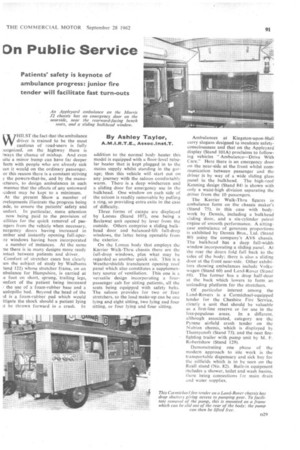Dn Public Service
Page 93

If you've noticed an error in this article please click here to report it so we can fix it.
Patients' safety is keynote of ambulance progress: junior fire tender will facilitate fast turn-outs
By Ashley Taylor, A.M.I.R.T.E., Assoc.I nst.T. WHILST the fact that the ambulance driver is trained to be the most cautious of road-users is fully !cognized, on the highway there is lways the chance of mishap. And even itite a minor bump can have far deeper Teets with people who are already sick ian it would on the ordinary passenger. or this reason there is a constant striving y the powers-that-be, and by the manuicturers, to design ambulances in such manner that the effects of any untoward icident may be kept to a minimum. At the present Show a number of :velopments illustrate the progress being Lade, to ensure the patients' safety and mlfort. In particular, more attention now being paid to the provision of cilities for the quick removal of pasngers from the vehicle when necessary, nergency doors having increased in imber and instantly opening full-aperre windows having been incorporated a number of instances. At the same -ne there is in many designs more ready mtact between patients and driver. Comfort of stretcher cases has clearly ;en the subject of study by Wadhams tand 122) whose stretcher frame, on an nbulanee for Hampshire, is carried at e foot on short, sprung, trailing legs, imfort of the patient being increased I the use of a foam-rubber base and a unlopillo bed. Beyond the head of the ;d is a foam-rubber pad which would itigate the shock should a patient lying it be thrown forward in a crash. In
addition to the normal body heater this model is equipped with a floor-level tubular heater that is kept plugged in to the mains supply whilst standing in the garage; thus this vehicle will start out on any journey with the saloon comfortably warm. There is a deep windscreen and a sliding door for emergency use in the bulkhead. One window on each side of the saloon is readily removable by pulling a ring, so providing extra exits in the case of difficulty.
Three forms of escape are displayed by Lomas (Stand 107), one being a Beclawat unit opened by lever from the outside. Others comprise a sliding bulkhead door and balanced-lift full-drop windows, the latter being openable from the exterior.
On the Lomas body that employs the Karrier Walk-Thru chassis there are the full-drop windows, plus what may be regarded as another quick exit. This is a Weathershields translucent opening roof panel which also constitutes a supplementary source of ventilation. This one is a versatile design incorporating a fourpassenger cab for sitting patients, all the seats being equipped with safety belts. The saloon provides for two or four stretchers, so the load make-up can be one lying and eight sitting, two lying and four sitting, or four lying and four sitting. Ambulances at Kingston-upon-Hull carry slogans designed to inculcate safetyconsciousness and that on the Appleyard display (Stand 10IA) proclaims to following vehicles " Ambulance—Drive With Care." Here there is an emergency door on the near-side at the front whilst communication between passenger and the driver is by way of a wide sliding glass panel in the bulkhead. The high-roof Kenning design (Stand 84) is shown with only a waist-high division separating the driver from the 10 passengers.
The Karrier Walk-Thru figures in ambulance form on the chassis maker's (Stand 75), in this case with bodywork by Dennis, including a bulkhead sliding door, and a six-cylinder petrol engine of smooth performance. A sittingcase ambulance of generous proportions is exhibited by Dennis Bros., Ltd. (Stand 80) using the company's AV6 chassis. The bulkhead has a deep full-width window incorporating a sliding panel. At the rear the doors fold full back to the sides of the body; there is also a sliding door at the front near-side. Other exhibitors showing ambulances include Volkswagen (Stand 60) and Land-Rover (Stand 88). The former has a drop half-door at the back which lowers to form an unloading platform for the stretchers.
Of particular interest among the Land-Rovers is a Carmichael-equipped tender for the Cheshire Fire Service, clearly a unit that should be valuable as a first-line reserve or for use in the less-populous areas. In a different, although associated, category are the Pyrene airfield crash tender on the Nubian chassis, which is displayed by Thornycroft (Stand 73), and the neat firefighting trailer with pump unit by M. F. Robertshaw (Stand 129).
Demonstrating one phase of the modern approach to site work is the transportable dispensary and sick bay for the oilfields which is to be seen on the Reall stand (No. 82). Built-in equipment includes a shower, toilet and wash basins, there being connections for main drain and water supplies.






































































































































































